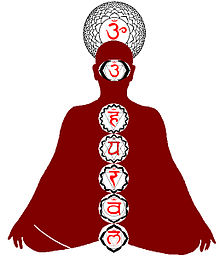Kundalini yoga

Kundalini Yoga is a yoga practice that plays an important role in tantrism in particular . Similar forms are Laya Yoga or Tantra Yoga. Also in Sikhism one knows a specific form of Kundalini Yoga, by Yogi Bhajan was brought to the West. Also plays in Kriya Yoga the Kundalini a role.
Shakta Tantra and Kundalini Yoga were first described in Western culture by Sir John Woodroffe under the pseudonym "Arthur Avalon" in the book "The Serpent Power" (1919). In the book one of the most important texts of Kundalini Yoga was partially translated: the sixth chapter of Purnanandas Shritattvacintamani. This chapter is called 'Mirror of the Seven Chakras' (Satcakranirupana) and represents the most detailed and influential consideration of Kundalini Yoga.
The aim of Kundalini Yoga is the awakening of Kundalini and their ascent through the chakras into the highest chakra, the Sahasrara, in order to experience enlightenment : because in Tantra this is achieved as an attainment or union with Atman , the cosmic consciousness ( Shiva ) with the divine Energy ( Shakti ). The process of yogic practice is to purify the nadis and chakras and to open the latter so that the ascending Kundalini is not blocked. According to the tantric teaching, a certain state of consciousness and certain Siddhi are associated with each chakra . The practice includes asana , pranayama , mudras , mantras and visualizations .
The ascent of Kundalini is said to eventually lead to Samadhi and Mukti , and it is believed that both are not possible without the awakening of Kundalini. Other forms of yoga such as bhakti yoga or raja yoga can also lead to the ascent of Kundalini according to the yogic teachings. According to these teachings, the purity of the body, the nadis, the spirit and the intellect is important when awakening the Kundalini, so that many methods are used for preparatory cleansing.
In Hindu tantra, many Kundalini yoga practices are only passed on to initiates.
Kundalini Yoga according to Yogi Bhajan
A form of Kundalini Yoga that was taught by the Sikh Yogi Bhajan is very common in the West . In contrast to Hatha Yoga , the exercises are often dynamic movements, but also asanas related to Hatha Yoga . The meditation focuses on mantras that come from Sikhism and refer to the holy scripture Adi Granth or were taken directly from it (cf. Mul Mantra ), but there are also other meditations. Also Mudras , Pranayama , internal concentration points Bandhas be used. The frequent practice of fire breathing is typical of this form of yoga .
A series of exercises is called a Kriya . A typical Kriya consists e.g. B. 45 minutes of physical exercises and postures, combined with pranayama, concentration on the so-called " third eye ", the mantra Sat Nam ("true identity"), on which one concentrates when inhaling and exhaling. This is followed by 15 minutes of relaxation lying down and a subsequent meditation (e.g. with mantras).
As part of this school of yoga, a spiritual healing art , gatka (stick and sword fighting), yoga for pregnant women and yogic nutrition and lifestyle are taught.
The practice of this form of yoga does not depend on any particular religion , but is shaped by the teachings of Sikhism .
literature
- Muktananda: Kundalini: the awakening of cosmic energy in people . Freiburg im Breisgau, Aurum-Verl., 1979
- Swami Narayanananda: The elemental force in humans or Kundalini Shakti. Blansingen, NU Yoga Ashram, 1981
- Sri Swami Sivananda : Science of Yoga; Vol. 4 / Hatha Yoga; Kundalini Yoga; Practice of Pranayama. Divine Life Society, 1st Indian ed. 1981
- Sivanda Sarasvati: Kundalini Yoga . Goldmann Wilhelm, 1994
- Swami Satyananda Saraswati: Kundalini Tantra . 2nd ed. Munger [and a.], Bihar School of Yoga, 1996
- Laue, Thorsten: Tantra in the West. A religious studies study on "White Tantra Yoga", "Kundalini Yoga" and "Sikh Dharma" in Yogi Bhajan's "Healthy, Happy, Holy Organization" (3HO) with special consideration of the "3H Organization Deutschland e. V. “ , Münster: LIT, 2012, zugl .: Tübingen, Univ., Diss., 2011, ISBN 978-3643114471
- Megarisiotis, Athanasios: Kundalini Yoga - Based on the teachings of Yogi Bhajan , Neuer Umschau-Verlag, 2007.
- Schwery, Walter: In the stream of awakening. The Kundalini path of the Siddhas and the individuation process according to CG Jung. Ansata 1988